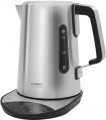Design
The design in which the electric kettle is decorated. In addition to
the classic design, nowadays there are more original styles, namely:
—
Retro. Devices stylized antique — mainly for kitchen utensils of the 30s — 50s of the XX century. The degree of stylization in this case can be different: for example, some appliances are not different from ordinary kitchen kettles that are placed on the stove. Also note that almost all samovars are performed in retro style (see "Type"). But thermopots and teapots in this design are almost never produced. Anyway, a retro kettle will be indispensable for a kitchen in the same style, but it can also fit into a modern interior.
—
Hi-tech. The devices that have a technological, sometimes even futuristic design — using unpainted metal, transparent glass, as well as a minimal amount (or even complete absence) of decorative details. At the same time, the design can be quite unusual: for example, there are models that taper upward and vaguely resemble laboratory flasks. Like the retro style, almost no other devices are produced in this style other than classic kettles.
When choosing a device in a specific design, note that the design inevitably affects the cost — sometimes quite noticeably, despite the fact that it usually does not provide functional advantages.
Water level indicator
A device that allows you to estimate the amount of water in the kettle without opening its lid. Most often
the water level indicator has the form of a scale applied either to the transparent wall of the container, or to a transparent insert in an opaque wall. In any case, this function allows you to measure the volume of filled water quite accurately, and not just determine it “by eye”. This possibility is especially important for models with open coils (see "Heating element"), in such devices, a mark on the indicator is usually applied to the minimum allowable water level.
Temperature adjustment
The temperature adjustment capabilities refer to the specific temperature values that can be programmed into the electric kettle. It's important to note that this refers to automatic adjustment, where the kettle turns off or switches to temperature maintenance mode once the desired temperature has been reached.
If this paragraph contains several options separated by commas (for example, “60 °С, 80 °С, 90 °С”), this means that this model has several fixed temperature options. However, there are also devices with
smooth adjustment, which allows you to adjust the temperature in steps of 5 °C, or even 1 °C; for such devices, the entire adjustment range is indicated here, for example, "60 — 100 °C".
The greater the number of temperature setting options available in an electric kettle, the more versatile it becomes, allowing for precise selection of the optimal brewing mode for various types of drinks. Here is a simple table of recommended temperatures:
—
white tea — 60 °C;
—
yellow tea -70 °C;
—
green tea — 80 °C;
—
black tea — 90 °C;
— rooibos, hibiscus — 100 °C (up to boiling);
—
baby food — 40 °C.
Of course, there are exceptions to such rules — depending on the specific type of drink. For example, some
...varieties of green tea can be brewed at 90 °C.
